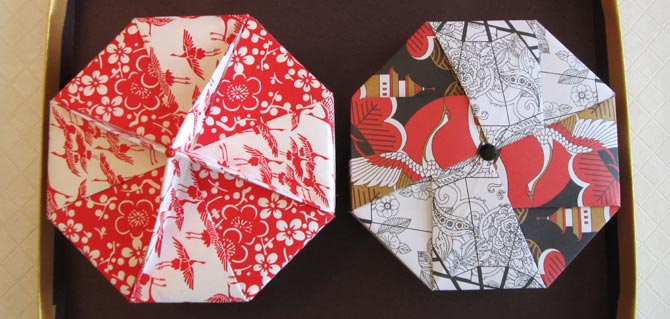|
Click on any origami item shown in the image below for a bigger image and more info.


Side View 

If you like the above, you may also like:
|
| Set ID #: | 1349 |
| Category: | Modular -- Small Octagonal |
| Lid Size: |
Assorted
|
| Base Size: |
Assorted
|
| Box Height: |
Assorted
|
| Style: | Modular Octagon - Assorted |
| Designer: | Tomoko Fuse |
| Design Source: | Decoration Boxes by Tomoko Fuse (Chikuma Shobo Publishing Co., Ltd., 1991) - in Japanese >> Click here
Fabulous Origami Boxes by Tomoko Fuse (Japan Publications Trading Co., Ltd., 1998) >> Click here
|
| Paper Type: |
Aitoh Chiyogami Washi Origami Paper (No. 2112) - Rice Paper
Yasutomo Fold 'Ems Chiyogami Origami Paper - Folk Art Patterns (4304)
Yasutomo Fold 'Ems Mineral Origami Paper (4510)
Sterling Publishing Japanese Origami Paper Pack
|
| Sheet Size: | 15 cm (5 7/8 in) Square |
| Sheets Used: | 16 (Lid - 8; Base - 8) or
8 (Lid - 4; Base - 4) |
| Paper Source: |
Pixie's Paper and Polish
Barnes & Noble
|
| Comments: | This is a mixed set, reflecting two different methods of creating modular origami models.
One method involves assembling a model from units that are all identical in structure. This is the most common approach to modular origami. The simpler box shown here (right hand side of image) is an example of the most common approach.
It has a lid made from four lid units with exactly the same structure, and a base made from four base units with exactly the same structure.
An alternative method for creating modular models involves combining units that are NOT identical in structure. The more complex box shown here (left hand side of image) is an example of that alternative approach.
It has eight units in the lid, but there are two different types of lid units (A and C). Four A lid units share the same structure, while four C lid units share a structure somewhat different from the A units. The two different types of lid units are alternated during the assembly process.
The base of the more complex box is also made from eight units, but again the units are not identical in structure. Two different types of base units (A and B) have been alternated during the assembly process. |
| |
|
Click here to see more Small Modular Octagons
|
|



